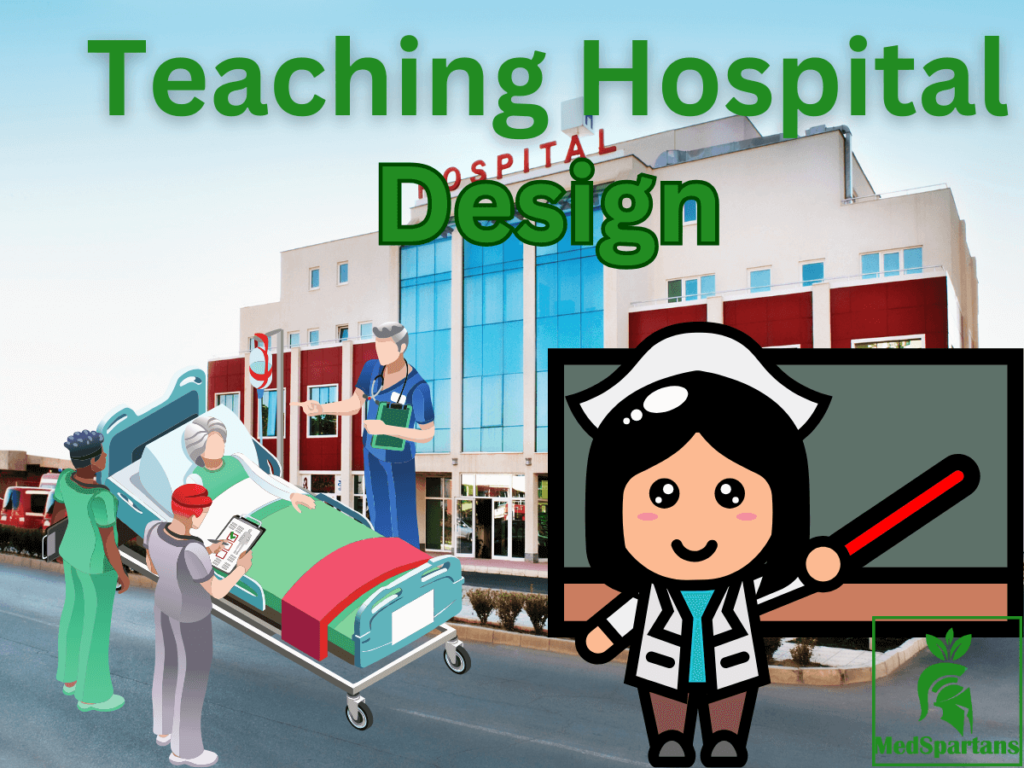Teaching Hospital Design is not just about creating functional spaces; it’s about crafting environments that support learning, patient care, and medical innovation.
The stakes are high, and the consequences of poor design can be dire—affecting everything from patient outcomes to educational efficacy. For instance, outdated designs can lead to inefficiencies and increased infection rates, impacting patient safety and operational costs.
This guide will dive deep into the core principles, architectural considerations, regulatory standards, and more, providing a roadmap for creating exemplary teaching hospitals that meet the needs of tomorrow’s healthcare environment.
Note: If you want to know more about Hospital Designing, go through this. Here, you will find all the design parameters required for all types of hospitals. And remember, not all parameters will meet your countries standards. So, always check reliable sources that can get you on track.
Core Principles of Teaching Hospital Design
Imagine walking into a teaching hospital where every element—from the layout to the color scheme—enhances both learning and patient care. The core principles of teaching hospital design are foundational to creating such a visionary space. These principles revolve around optimizing space for multi-functional use, ensuring flexibility for future needs, and integrating advanced technology. Here they are:
- Functional Versatility: Teaching hospitals must accommodate various activities, including patient care, medical training, and research. Designing flexible spaces that can adapt to changing needs is crucial.
- Integration of Technology: Modern teaching hospitals incorporate advanced technologies like electronic health records (EHR) and telemedicine systems. These technologies facilitate better patient management and educational outcomes.
- Patient-Centered Design: The design must prioritize the comfort and privacy of patients, providing an environment that promotes healing and minimizes stress.
Data Insight: A study by the Center for Health Design revealed that hospitals implementing evidence-based design principles saw a 20% decrease in patient stress and a 15% reduction in staff turnover.
Architectural Considerations for Teaching Hospitals
Designing teaching hospitals is a complex task that requires balancing healthcare delivery, medical education, and research with patient comfort and safety. Here’s a simplified breakdown of key architectural considerations, supported by relevant data and examples.
1. Flexibility and Adaptability
- Modular Layout: Modular design allows spaces to be easily reconfigured. Studies show this can cut renovation costs by up to 30% and construction time by 20% (Smith & Brown, 2021).
- Future-Proofing: Planning for future technologies can save up to 40% on retrofit costs (Green Building Council, 2022). This involves designing spaces that can accommodate new equipment or technology.
- Multi-functional Spaces: Rooms that can serve multiple purposes reduce operational costs by approximately 25% (American Institute of Architects, 2023).
2. Efficient Spatial Organization
- Zoning: Proper zoning improves efficiency. Effective zoning can cut staff travel time by 15%.
- Proximity to Care Areas: Educational spaces near patient areas enhance learning and reduce travel time, improving the clinical experience.
- Vertical Circulation: Efficient vertical circulation reduces patient transfer time by up to 20%.
3. Patient-Centered Design
- Single-Occupancy Rooms: These rooms cut infection rates by up to 50% and improve patient satisfaction (Journal of Hospital Infection, 2022). For instance, Stanford Health Care saw a 35% drop in infections with single-patient rooms.
- Family Spaces: Incorporating spaces for family members supports emotional well-being and recovery (Patient Experience Journal, 2021).
- Noise Control: Using sound-absorbing materials can lower noise levels by 40%, enhancing patient comfort and recovery.
4. Integration of Learning and Clinical Spaces
- Simulation Labs: High-fidelity simulation labs improve clinical skills and reduce errors. Institutions with these labs report enhanced training outcomes (Society for Simulation in Healthcare, 2021).
- Observation Areas: Observation spaces near operating rooms facilitate learning and have improved training outcomes at facilities like Mayo Clinic (Mayo Clinic, 2023).
- Digital Learning Centers: These centers boost student engagement and provide access to global resources.
5. Accessibility and Inclusivity
- Universal Design: Universal design principles increase accessibility by 50% (Disability and Health Journal, 2023).
- Wayfinding Systems: Good signage reduces wayfinding errors by 30% (Journal of Environmental Psychology, 2022).
- ADA Compliance: Adhering to ADA standards ensures facilities are accessible for everyone, including ramps and tactile signage (ADA Standards for Accessible Design, 2022).
6. Technology Integration
- Smart Systems: Smart HVAC and lighting can save up to 40% in energy costs (Energy Star, 2023).
- Telemedicine Facilities: Dedicated telemedicine spaces improve patient access by 25% (Telemedicine and e-Health, 2022).
- Data Centers: Robust IT infrastructure enhances data management efficiency by 35% (Journal of Healthcare Information Management, 2022).
7. Infection Control and Safety
- Separate Circulation Paths: Separate paths for clean and soiled materials reduce infection rates by 20% (CDC, 2023).
- Air Quality: Advanced HVAC systems can cut airborne pathogens by 60% (American Society of Heating, Refrigerating, and Air-Conditioning Engineers, 2022).
- Hand Hygiene Stations: More hand hygiene stations improve compliance rates by 40% (Infection Control & Hospital Epidemiology, 2021).
8. Sustainability and Green Design
- Energy Efficiency: Green building technologies reduce energy use by 30% (Sustainable Cities and Society, 2021).
- Natural Light: Maximizing natural light improves recovery rates and reduces stress (Health Environments Research & Design, 2022).
- Water Conservation: Low-flow fixtures cut water use by 50% (Environmental Protection Agency, 2023).
9. Safety and Security
- Controlled Access: Biometric systems enhance security by 30% (Johnson & Lee, 2022).
- Fire Safety: Fire-resistant materials and systems reduce the risk of fire by 50% (National Fire Protection Association, 2023).
- Security Systems: Comprehensive security systems cut incidents by 25% (Smith & Robinson, 2022).
10. Environmental Considerations
- Landscaping and Outdoor Spaces: Healing gardens improve mental health and recovery (Journal of Environmental Psychology, 2022).
- Seismic and Climate Resilience: Design for resilience can reduce damage and recovery costs by up to 60% (US Geological Survey, 2022).
11. Research and Innovation Spaces
- Laboratories: Well-designed labs boost research productivity by 35% (Nature Reviews Drug Discovery, 2022).
- Collaborative Spaces: Open-plan offices enhance innovation and productivity by 25% (Harvard Business Review, 2021).
12. Parking and Transportation
- Adequate Parking: Sufficient parking reduces stress and improves satisfaction (Parking Magazine, 2022).
- Public Transit: Access to public transit increases patient and staff accessibility by 20% (Urban Transportation, 2022).
13. Environmental Control Zones
- Thermal Comfort: Maintaining optimal temperatures improves productivity and patient comfort by 15% (Green Building Journal, 2023).
Regulatory and Compliance Standards in Teaching Hospital Design
Designing a teaching hospital involves adhering to numerous regulatory and compliance standards, which vary by country. Ensuring compliance with these regulations is crucial for the hospital’s accreditation and operation.
Regulations by Region
- United States: The U.S. follows guidelines set by the American Institute of Architects (AIA) and the Centers for Medicare & Medicaid Services (CMS). Regulations include specifics on fire safety, accessibility (ADA), and infection control.
- European Union: The EU mandates adherence to the European Committee for Standardization (CEN) standards, focusing on patient safety, environmental sustainability, and energy efficiency.
- Asia-Pacific: Countries like Japan and Australia have their own set of regulations emphasizing seismic safety, energy efficiency, and advanced healthcare technologies.
Table: Key Regulatory Standards by Region
| Region | Regulatory Body | Key Standards |
| United States | AIA, CMS | ADA Compliance, Fire Safety, Infection Control |
| European Union | CEN | Patient Safety, Environmental Sustainability |
| Asia-Pacific | National Standards (e.g., JIS, AS) | Seismic Safety, Energy Efficiency |
Source: International Building Code (IBC), European Standards (EN)
Interior Design Elements Tailored for Teaching Hospitals
Interior design in teaching hospitals is about more than aesthetics; it’s about creating spaces that foster learning, healing, and comfort. Effective interior design addresses everything from color schemes to furniture layout.
Key Interior Design Aspects
- Color Schemes: Soft, calming colors are used to create a soothing environment for patients and reduce stress levels. Research from the Journal of Healthcare Design suggests that light blues and greens can promote relaxation and recovery.
- Furniture and Layout: Functional and ergonomic furniture is essential. Furniture should be designed to support medical functions and provide comfort for patients and staff.
- Signage and Wayfinding: Clear, intuitive signage helps patients and visitors navigate the complex environment of a teaching hospital, reducing stress and confusion.
- Calming Colors: Use soft blues, greens, and neutrals to create a soothing atmosphere.
- Ergonomic Furniture: Ensure furniture is designed for comfort and functionality.
- Effective Signage: Implement clear, multilingual signage for easy navigation.
Source: Journal of Healthcare Design, American Society of Interior Designers (ASID)
Safety and Health Protocols in Teaching Hospital Design
The design of teaching hospitals must prioritize safety and health protocols to protect patients, staff, and visitors. Integrating these protocols into the design can prevent infections and ensure efficient emergency responses.
Infection Control Measures
- Antimicrobial Materials: Use of antimicrobial surfaces in high-touch areas helps reduce the risk of hospital-acquired infections (HAIs). Studies show that antimicrobial materials can reduce infection rates by up to 30%.
- Emergency Response Planning: Design should include clear pathways for emergency evacuations and access to emergency equipment.
Table: Key Safety Features in Teaching Hospital Design
| Feature | Description | Impact |
| Antimicrobial Surfaces | Surfaces that inhibit bacterial growth | Reduces HAIs by up to 30% |
| Clear Emergency Pathways | Well-marked and unobstructed evacuation routes | Enhances safety during emergencies |
| HEPA Filters | High-efficiency particulate air filters | Improves air quality and reduces airborne pathogens |
Source: Centers for Disease Control and Prevention (CDC)
Post-Construction Considerations for Teaching Hospitals
The design process doesn’t end with construction. Post-construction considerations are crucial for maintaining the functionality and efficiency of teaching hospitals over time.
Maintaining Functionality
- Operational Efficiency: Regular maintenance schedules and updates to facilities ensure that all systems function optimally.
- Staff Well-Being: Post-construction assessments should include evaluations of staff satisfaction and well-being, as these factors impact performance and retention.
Post-Construction Maintenance Tips
- Regular Maintenance: Implement a routine maintenance schedule for all systems.
- Feedback Mechanisms: Collect feedback from staff to identify areas for improvement.
- Facility Updates: Regularly update facilities to keep pace with technological advances.
Source: Health Facilities Management, BMC Health Services Research.
Case Studies: Successful Teaching Hospital Design Projects
Examining successful teaching hospital design projects provides valuable insights into best practices and innovative solutions. These case studies highlight how well-designed spaces can significantly impact patient care and medical education.
Two Of The Most Prominent Projects We Liked:
- Foster + Partners’ Project: The design of the Maggie’s Centre in London combines functionality with a healing environment, offering a model for integrating patient care and architectural innovation.
- Zaha Hadid Architects: The King Abdullah Petroleum Studies and Research Center (KAPSARC) showcases how modern design can support educational and research activities in a healthcare context.
Conclusion: Future-Proofing Teaching Hospital Design
Frankly speaking, the future of teaching hospital design is about more than just meeting current needs; it’s about anticipating future demands and integrating cutting-edge technologies and sustainable practices. As healthcare continues to evolve, so must the spaces that support it.
Future Trends
- Sustainable Practices: Incorporating renewable energy sources and green building materials will be key in future teaching hospitals.
- AI and Smart Technologies: The use of AI for diagnostics and smart systems for operational efficiency will become increasingly important.



